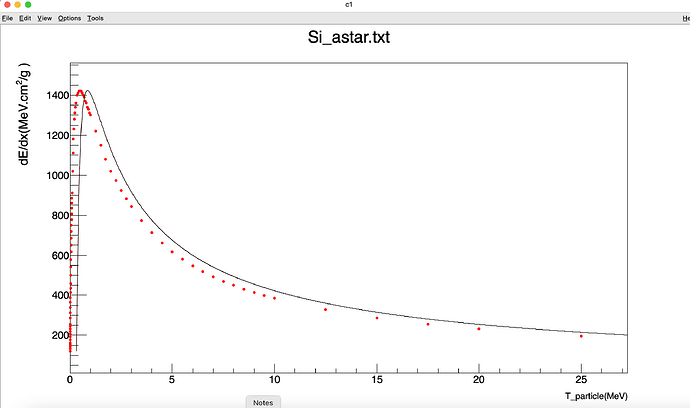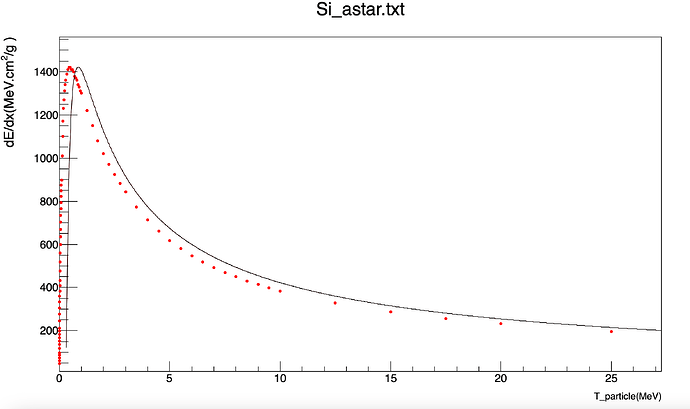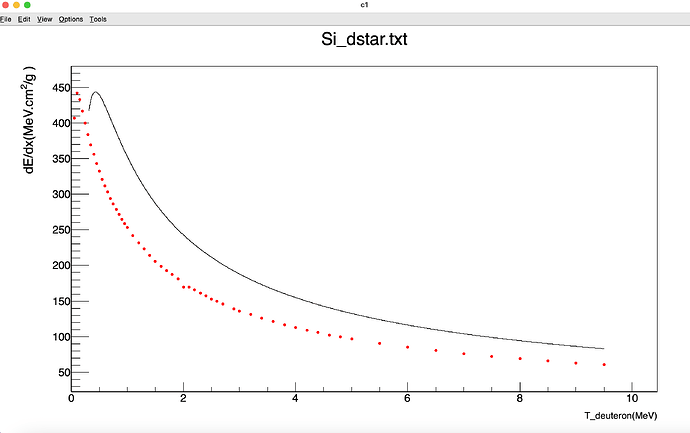Thanks.
The data is from https://physics.nist.gov/PhysRefData/Star/Text/ASTAR.html.
Si_astar.txt (9.3 KB)
First column of this data is T_alpha and the 4th column is STP_alpha. Anyways, the kinetic energy starts from 1.e-3 MeV. However, my code tells me the term in parenthesis in the equation goes minus values after 0.316MeV. That means the STP_alpha also becomes negative which shows the energy limit.
Why do you think they put the data starting from 1.e-3 MeV? Do you think their formula is different?
Total STP fit:
Electronic STP fit:
I haven’t checked why my function is not fitted right on top!? Is it because the function I use is not representing the true data?
I can guess that I only added STP due to ionization and excitation (this is part of electronic STP), not the TOTAL STP. However, their data on the 4th column shows total STP. The fit only works when I set the minimum kinetic energy, like I said, to 0.316MeV.
Hi,
as I already told you t
So for proton it means your formula is valid from T_{min}\sim 1 MeV and for \alpha T_{min}\sim 4.5 MeV , while for your maximum range the behte bloch without the \delta correction works just fine. ( PDG consider Bethe-Bloch valid only down to 0.1 \beta\gamma\sim0.1 )
Moreover on the NIST site where you took the data, here in section 3.5 you can find how they evaluate the data. And how they use Bethe Bloch only down to 0.5 MeV for proton and 2 MeV for \alpha.
In section 3.5.2 they describe from where tehy took the formulas for proton and \alpha stopping power. The Andersen and Ziegler reference describes an empirical formula for the stopping power of low energy particles (this is valid for proton, but I think should works also for \alpha),where the Bethe Bloch fails.
Hope this helps.
1 Like
@Dilicus
Is it OK to make the fit better by introducing a coefficient into the function which we think it is not working for all energy regime? For instance, we know if we use f(x-2) instead of f(x) that we can shift the function to the right. In the case of f(x+2), we make a shift to the left. We can even make it f(x/2) or f(2*x) to shift up or down.
I mean, instead of trying to find a better formula, can we do this with little touch! Maybe, I should ask how people end up finding the correction parameters, how do they decide what to do?
For instance, no matter what range I tried, this is the best fit I got. That only means the formula is not valid in all energies.
Shifting the function doesn’t solve your problem, not even shift up or down (to shift up or down a fucntion you have to multiply k\times f(x), multiply the function argument rescale the x axis)
To have a better fit I see only 2 options
- Reduce your fitting range, where the BB works
- Define a piece wise function according to the energy range.
1 Like
Thanks. Just reading the pdfs you sent earlier now.



